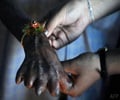Archaeologists and scientists have found a 4000-year-old skeleton in India, which bears the oldest evidence of leprosy.
A 4000-year-old skeleton has been discovered in India by scientists and archaeologists which is the earliest proof of the existence of leprosy.
The skeleton represents both the earliest archaeological evidence for human infection with Mycobacterium leprae in the world and the first evidence for the disease in prehistoric India.Conducted by a collaborative team of Appalachian State University researchers, and a team of archaeologists from Deccan College (Pune, India), the study demonstrates that leprosy was present in human populations in India by the end of the mature phase of the Indus Civilization (2000 B.C.).
The finding provides support for one hypothesis about prehistoric transmission routes for the disease.
It also supports the hypothesis that the Sanskrit Atharva Veda, composed before the first millennium B.C., is the earliest written reference to the disease.
In addition, the study revealed that burial traditions in the second millennium B.C. in one northwestern Indian village bear some resemblance to practices in Hindu tradition today.
In the study, the researchers reported on a case of leprosy in a skeleton buried around 2000 B.C. in Rajasthan, India, at the site of Balathal.
Advertisement
The presence of leprosy in India toward the end of this period indicates that M. leprae existed in South Asia at least 4000 years ago.
Advertisement
Now, the researchers are trying to recover ancient DNA from the skeleton to determine if the strain of M. leprae infecting the individual from Balathal is similar to strains common in Africa, Asia and Europe today.
If successful, this work could shed additional light on the origin and transmission routes of this disease.
Understanding more about the disease can help clear up some of the many popular misconceptions about leprosy, like the disease is generally linked with outcast and neglected people suffering their contagion on the margins of urban centres in late Biblical or Medieval times.
In reality, leprosy is transmitted only through prolonged close contact with nasal droplets or infected regions of the body. It is not highly contagious and the infection can remain latent for decades.
In fact, most people infected with Mycobacterium leprae have few or very mild symptoms.
The study has been published in the open-access, peer-reviewed journal PLoS ONE.
Source-ANI
SAV










